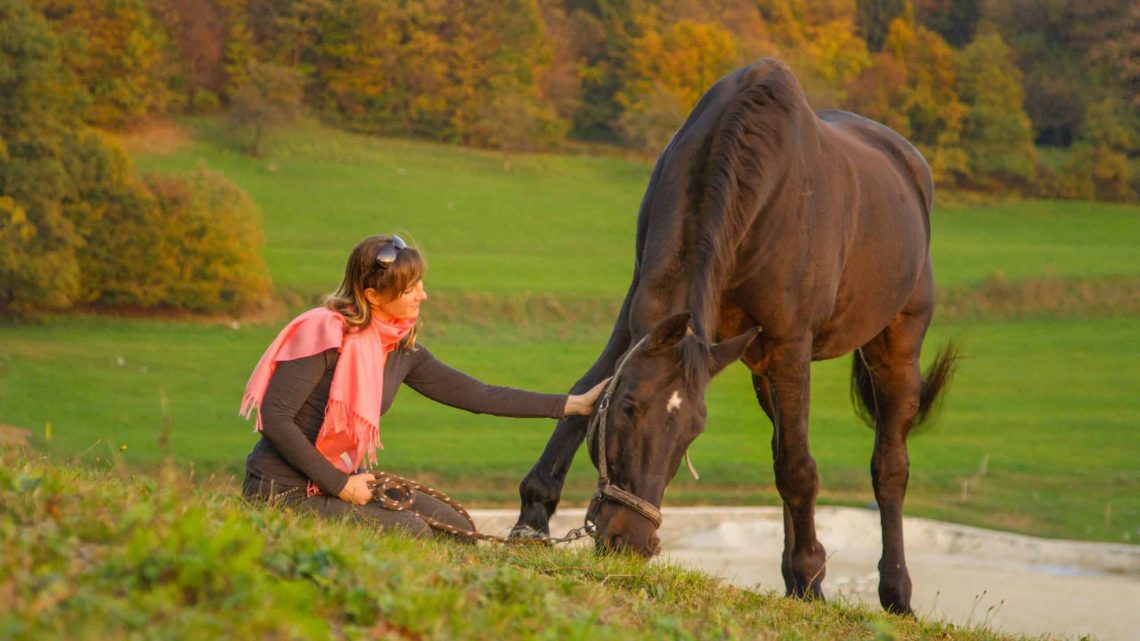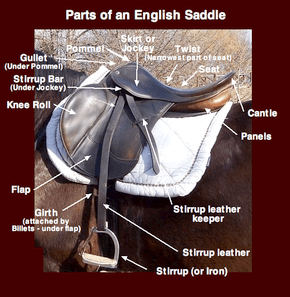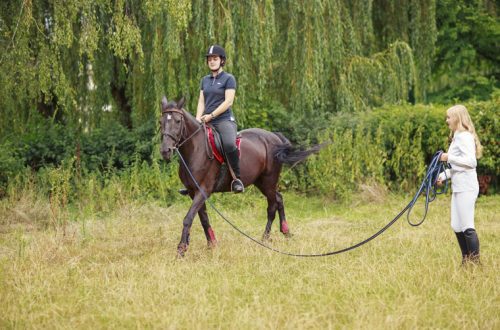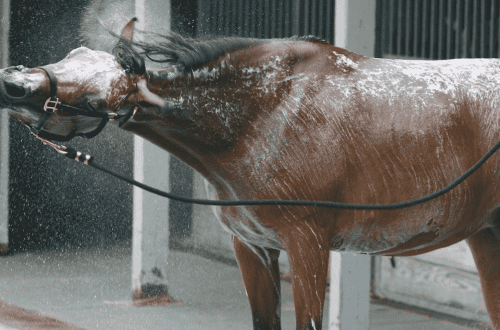
آرام کردن یک اسب عصبی (رویکردی دیگر)
آرام کردن یک اسب عصبی (رویکردی دیگر)
It’s a great day, not a cloud in the sky, and you’re off on a horseback ride. You have been planning it for quite some time and are looking forward to discovering new places.
Unfortunately, your horse is worried. Even during the cleaning and saddle she showed signs of nervousness, and now, when you sit in the saddle, you can literally feel her anxiety through the reins, by the way she fiercely gnaws on iron, and with your whole body, because she begins to dance on the spot. It seems that you are sitting on a bomb that is about to explode.
A tense, nervous horse can ruin the joy of a ride. It is impossible to relax and enjoy it when your horse is irritated and you are worried that he will start to goat, flash, spin in place, tremble or rush at all gaits, try to hit other horses … You begin to worry about your own safety …
“There is a big difference between a horse that is agitated or tense and a horse that is scared,” notes eminent trainer Linda Tellington-Jones. – A tense horse is often wary of contact with the mouth, flanks or belly and overreacts to the legs. She may be afraid to touch any point on her body and tense her abdominal muscles. Tense, restless horses tend to show their anxiety all the time, unlike a frightened horse that “explodes” suddenly” or a “playing” horse. riding on a restless horse, you may inadvertently make it worse. So, you can start using the controls in a “defensive” manner by taking the reins shorter. However, when you tighten the reins, you create additional tension in the horse’s neck and encourage him to lift his head. And this, in turn, can switch the horse into a “scared” mode. Additional tension affects the horse’s breathing and can create additional problems, because the horse becomes enslaved. Her tense muscles interfere with normal blood flow, and, accordingly, the supply of oxygen to the brain, the horse stops thinking clearly. Neuro impulses are blocked, making her less able to feel her limbs.”
The solution is to teach the horse to find his psychological, physical and emotional balance. This can be done with Tellington TTouches (a form of horse body work where you do a lot of circles, ups and downs with the pads of your fingers or palms), Tellington exercises in the arms, and work under the saddle.
Three TTouch and one hand/under saddle exercise designed to calm a nervous horse will be described below.
TTouch № 1. Serpentine upward movement
This TTouch is great for relieving muscle tension in the back and increasing blood flow. It relaxes a nervous horse, increases his confidence and body awareness, and helps to “eliminate” the flight reflex.
امتیاز کلیدی: legs, back, inner thighs.
چگونه انجامش بدهیم: start at the top of the horse’s underarm. Place your hands on either side of your leg. Start the movement with “two-way pressure”. (See below for details on how much pressure should be applied.)
Make a circle and a quarter circle with one hand, then pull the skin up with both hands with enough contact so that your hands do not slip over the horse’s skin. Hold the hand position for a few seconds as the skin slowly returns to its normal position.
توجه داشته باشید. Your touch simply stretches the skin upward, increasing circulation and minimizing the effects of gravity for those few moments.
Move your arms a few inches and repeat the circle and lift. Work from the top of the leg to the bottom. If the horse withdraws his leg from being touched, you are squeezing too hard or pulling back too hard on the skin.
TTouch No. 2. Cow tongue
This TTouch got its name thanks to the lingering, smooth sliding movements from the middle of the abdomen to the middle of the back. Touch improves your horse’s flexibility, coordination, and helps calm a tense or “frightened” horse that doesn’t like pressure on the legs.
امتیاز کلیدی: بدن است.
چگونه انجامش بدهیم: to calm a tense horse, use a flat palm as the curved fingers are stimulating and energizing. Stand at the girth area. Place one hand on the horse’s back and the other on the midline of the abdomen, just behind the elbow.
Run your bottom hand over the hair growth in a long, soft, continuous motion. As you get closer to the middle of the belly, turn your hand so that your fingers are pointing up at the top line of the horse.
Continue in a gentle upward motion until you reach the middle of your horse’s topline. Finish the movement when you cross the spine.
Start the next movement at the distance of the palm of your hand from the place where the first one began (about 10 cm) – this way you will move from the elbow to the groin.
Try applying different pressure and speed on both sides of the horse.
TTouch № 3. Chimpanzee touch
This TTouch is named after the slightly bent fingers of a chimpanzee. Touch is not difficult to use and is ideal for improving communication with the horse. With this TTouch, you are less likely to irritate her in sensitive areas. TTouch will enhance your horse’s awareness of his entire body, something horses often lack.
امتیاز کلیدی: the whole body of the horse.
چگونه: keep the hand gently bent at the fingers. Touch the horse using the flat surface on the back of your fingers between the second and third knuckles. Move your hand in this position, creating circles and connecting lines, using “two pressures” – “three pressures” all over her body.
یک تمرین. We lower our heads
A nervous or anxious horse often throws its head up (as we see it in the run mode).
Teaching a horse to lower its head is of great importance in reducing its level of anxiety. A lowered head is a sign of relaxation and trust, but more importantly, it encourages an anxious or frightened horse to change his mood.
This lesson can be one of the most important, especially if you have a tense and anxious horse. Lowering the head down cancels the “flight” instinct and helps to turn a frightened, stargazing, unpredictable horse into a completely balanced one. This not only relieves muscle tension in the horse’s neck and back, but also promotes relaxation, trust and cooperation.
Ideally, you want the horse to lower his head so that the back of his head is slightly lower than the withers, and his nose is no lower than the level of the wrist.
You will need a halter, a lead with a chain and a Tellington stick (long (1,20 m), hard white dressage whip with a plastic “button” on the end). The wand acts as an extension of your hand. If you don’t have one, use a dressage whip.
Before you begin, thread the chain through the lower left ring of the halter, pass it under the horse’s chin, and thread it into the lower right ring. Attach a carabiner to the upper right ring. (This will make it easier to get the horse to lower its head than if you run the chain over its nose.)
Once the horse responds to your requests and lowers its head, you can shorten the chain by passing it through the upper left ring and then back through the lower left ring.
گام 1. فشار به پایین. Stand to the left of the horse and ask him to lower his head: hold the end of the lead in your left hand and slide down with your right hand. (Do not hold the horse! The chain should give a light and subtle signal). This downward pressure should be brief but clear.
2 گام. نوازش. At the same time, use a stick (or dressage whip) to lightly stroke the horse’s neck, chest, and legs down towards the ground. Stroking is a soothing form of reward. Besides, it prevents the horse from moving forward. You can lean forward, but stay away from the horse, not in front of it.
Step 3: Apply pressure to your nose. As soon as the horse accepts the request to lower his head in response to the above signals, stand in front of him. Place one hand lightly on the nose, and with the other, take the chain and ask her to lower her head.
Step 4. Comb pressure. After the horse has willingly lowered its head in response to the above signals, have it lower its head by placing one hand on the nose and the other on the crest near the poll. Hand work carefully, bend your fingers and use the pads, making small circular touches on the comb. For the first time, gently rocking the horse’s head from side to side (hold the horse by the nose) will help you achieve your goal.
Step 5. Sit in the saddle. Once the horse learns to lower its head when you put your hand on the comb, you can act on it directly from the saddle. Once in the saddle, reinforce this signal by moving your hand forward and performing TTouch on the ridge.
چند تا لازم فشار؟
The TTouch pressure ranges from 1 to 9. “One Touch” is the lightest contact you can make with your fingertips to move the skin in a circle + quarter without sliding over the surface of the coat.
Tellington-Jones recommends “three pressures” for most parts of the horse’s body. This should reduce tension and promote relaxation. TTouch is not a form of massage. The goal is to communicate with the body on a cellular level. To know the level, start with “one pressure” as a guide.
To set this criterion, put your thumb on your cheek. With the tip of your middle finger, try to pull the skin of the eyelid and make a circle + quarter in the gentlest way. (Remember to move the skin, not just slide over it). Remove your finger and repeat this movement on your forearm to feel the pressure. Watch how you pull the skin. This is the “one pressure” TTouch.
To understand that there are “three pressures”, do a few circles on your eyelid with a slightly stronger pressure (you should be comfortable, the movement should be safe). Repeat circles on the forearm, noting the depth and how the skin moves. The touch should still be very light.
For “six pressures,” bend your fingers at the knuckles so that your nails point directly into the muscle, and apply pressure.
Apply enough pressure so that the movement is effective without causing discomfort to the horse. Listen to your horse’s reactions to your TTouch.
Ear work
Stroking the ears and doing small circular TTouch movements on the ears is the basis of Linda Tellington-Jones’ work. Ear work is effective in lowering the horse’s pulse and breathing, it makes him relax, relieves colic, encourages proper digestion, helps an exhausted horse and a horse in shock. You can use TTouches when riding on the trail when you are away from veterinary care. For more information on how to do TTouches on the horse’s ears, visit the website. www.ttouch.com/horsearticlecolic.shtml.
انتقال والریا اسمیرنوا (منبع).





